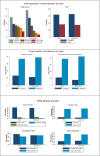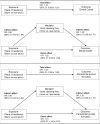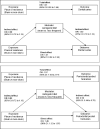Prevalence and determinants of oral health conditions and treatment needs among slum and non-slum urban residents: Evidence from Nigeria
- PMID: 36962169
- PMCID: PMC10021815
- DOI: 10.1371/journal.pgph.0000297
Prevalence and determinants of oral health conditions and treatment needs among slum and non-slum urban residents: Evidence from Nigeria
Abstract
Oral diseases constitute a neglected epidemic in Low and Middle-Income Countries (LMICs). An understanding of its distribution and severity in different settings can aid the planning of preventive and therapeutic services. This study assessed the oral health conditions, risk factors, and treatment needs among adult residents in the slum and compared findings with non-slum urban residents in Ibadan, Nigeria. The Multistage sampling was used to select adult (≥18-years) residents from a slum and a non-slum urban sites. Information sought from participants included dietary habits, oral hygiene practices, and the use of dental services. Oral examinations were performed in line with WHO guidelines. Associations were examined using logistic regression. Mediation analysis was undertaken using generalized structural equation modeling. The sample comprised 678 slum and 679 non-slum residents. Median age in slum vs non-slum was 45 (IQR:32-50) versus 38 (IQR:29-50) years. Male: female ratio was 1:2 in both sites. Prevalence of oral diseases (slum vs non-slum sites): dental caries (27% vs 23%), gingival bleeding (75% vs 53%) and periodontal pocket (23% vs 16%). The odds of having dental caries were 21% higher for the slum dwellers compared to non-slum residents (OR = 1.21, 95% CI:0.94 to 1.56); and 50% higher for periodontal pocket (OR = 1.50, 95%CI: 1.13 to 1.98), after adjusting for age and sex. There was little evidence that tooth cleaning frequency mediated the relationship between place of residence and caries (OR = 0.95, 95%CI: 0.87 to 1.03 [indirect effect], 38% mediated) or periodontal pocket (OR = 0.95, 95%CI: 0.86 to 1.04, 15% mediated). Thirty-five percent and 27% of residents in the slum and non-slum sites respectively required the "prompt and urgent" levels of treatment need. Oral diseases prevalence in both settings are high and the prevalence was generally higher in the slum with correspondingly higher levels of prompt and urgent treatment needs. Participants may benefit from targeted therapeutic and health promotion intervention services.
Copyright: © 2022 Osuh et al. This is an open access article distributed under the terms of the Creative Commons Attribution License, which permits unrestricted use, distribution, and reproduction in any medium, provided the original author and source are credited.
Conflict of interest statement
The authors have declared that no competing interests exist.
Figures



Similar articles
-
Oral health in an urban slum, Nigeria: residents' perceptions, practices and care-seeking experiences.BMC Oral Health. 2023 Sep 9;23(1):657. doi: 10.1186/s12903-023-03303-5. BMC Oral Health. 2023. PMID: 37689626 Free PMC article.
-
Systematic review of oral health in slums and non-slum urban settings of Low and Middle-Income Countries (LMICs): Disease prevalence, determinants, perception, and practices.PLoS One. 2024 Nov 8;19(11):e0309319. doi: 10.1371/journal.pone.0309319. eCollection 2024. PLoS One. 2024. PMID: 39514587 Free PMC article.
-
Prevalence and determinants of hypertension among urban slum dwellers in Bangladesh.BMC Public Health. 2022 Nov 11;22(1):2063. doi: 10.1186/s12889-022-14456-3. BMC Public Health. 2022. PMID: 36368965 Free PMC article.
-
Prevalence and correlates of tobacco use among urban adult men in India: a comparison of slum dwellers vs non-slum dwellers.Indian J Dent Res. 2012 Jan-Feb;23(1):31-8. doi: 10.4103/0970-9290.99034. Indian J Dent Res. 2012. PMID: 22842246
-
Prevention and control of dental caries and periodontal diseases at individual and population level: consensus report of group 3 of joint EFP/ORCA workshop on the boundaries between caries and periodontal diseases.J Clin Periodontol. 2017 Mar;44 Suppl 18:S85-S93. doi: 10.1111/jcpe.12687. J Clin Periodontol. 2017. PMID: 28266120
Cited by
-
Oral health in an urban slum, Nigeria: residents' perceptions, practices and care-seeking experiences.BMC Oral Health. 2023 Sep 9;23(1):657. doi: 10.1186/s12903-023-03303-5. BMC Oral Health. 2023. PMID: 37689626 Free PMC article.
-
Oral health-related quality of life in the East African community: a scoping review.BMC Oral Health. 2025 Apr 10;25(1):518. doi: 10.1186/s12903-025-05921-7. BMC Oral Health. 2025. PMID: 40211243 Free PMC article.
-
"Since I never felt pain, it didn't occur to me to visit a dental clinic": a qualitative exploration of social perceptions and influencers of oral care-seeking behaviour among adult Nigerians.BMC Oral Health. 2025 Jul 18;25(1):1196. doi: 10.1186/s12903-025-06634-7. BMC Oral Health. 2025. PMID: 40682060 Free PMC article.
-
Using traditional rhyme (folk song) as a tool for oral hygiene promotion (UTRATOHP) among children in rural communities in Nigeria: A protocol for a randomised controlled trial.PLoS One. 2023 Jun 2;18(6):e0280856. doi: 10.1371/journal.pone.0280856. eCollection 2023. PLoS One. 2023. PMID: 37267257 Free PMC article.
-
Prevalence and associated factors of self-reported oral health problems among adults in the Fanteakwa districts in Ghana.BMC Oral Health. 2025 Jan 11;25(1):57. doi: 10.1186/s12903-024-05405-0. BMC Oral Health. 2025. PMID: 39799286 Free PMC article.
References
-
- Ezeh A, Oyebode O, Satterthwaite D, Chen Y-F, Ndugwa R, Sartori J, et al. The health of people who live in slums 1 The history, geography, and sociology of slums and the health problems of people who live in slums. The Lancet. 2016;389(10068):547–58. - PubMed
-
- Saglio-Yatzimirsky M-C. Dharavi: from mega-slum to urban paradigm. e-book edition ed. London: Routledge; 2021. 1 February 2021. 379 p.
-
- Simon FR, Adeoke A, Adewale B. Slum Settlements Regeneration in Lagos Mega-city: an Overview of a Waterfront Makoko Community. International Journal of Education and Research 2013;1(3):1–16.
-
- Pat-Mbano E, Nwadiaro E. The rise of urban slum in Nigeria: implications on the urban landscape. International Journal of Development and Management Review (INJODEMAR) 2012;7:257–69.
LinkOut - more resources
Full Text Sources
